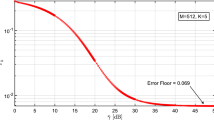Abstract
This paper presents a correlation reduction precoding scheme for joint decoding in an overloaded multiple input multiple output (MIMO)-orthogonal frequency division multiplexing system. In the overloaded MIMO system, the number of receive antenna elements is less than that of transmit antenna elements. Through joint maximum likelihood (ML) decoding a frequency diversity suppresses the BER degradation owing to the spatial multiplexing of signal streams. On a Rician channel, the correlation among coded symbols deteriorates the performance of the joint ML decoding. Thus, this paper proposes the precoding scheme that reduces the correlation on the Rician channel. Numerical results obtained through computer simulation show that the proposed scheme improves the BER by a factor of 1/10 on the Rician channel with a Rician factor of 10.













Similar content being viewed by others
References
NTT DoCoMo. (2012). Requirements, candidate solutions and technology roadmap for LTE rel-12 onward. 3GPP RWS-120010, June 2012.
Foschini, G. J. (1996). Layered space-time architecture for wireless communication in a fading environment when using multi-element antennas. Bell Labs Technical Journal, 1(2), 41–59.
Foschini, G. J., & Gans, W. J. (1998). On limits of wireless communication in a fading environment when using multiple antennas. Wireless Personal Communication, 6(3), 314–335.
Marzetta, T. L. (2010). Noncooperative cellular wireless with unlimited numbers of base station antennas. IEEE Transactions on Wireless Communications, 9(11), 3590–3600.
Rusek, F., Persson, D., Buon, L. K., Larsson, E. G., Marzetta, T. L., Edfors, O., et al. (2013). Scaling up MIMO: Opportunities and challenges with very large arrays. IEEE Transactions on Signal Processing Magazine, 30(1), 40–60.
Grant, S. J., & Cavers, J. K. (1998). Performance enhancement through joint detection of cochannel signals using diversity arrays. IEEE Transactions on Communications, 48(8), 1038–1049.
Bakinde, N., Zhu, X., Gao, J., & Nandi, K. (2008). Improved signal detection approach using genetic algorithm for overloaded MIMO systems. In IEEE 4th international conference on wireless communications, networking and mobile computing (Vol. 2).
Wong, K., Paulraj, A., & Murch, R. D. (2007). Efficient high-performance decoding for overloaded MIMO antenna systems. IEEE Transactions on Wireless Communications, 6(5), 1833–1843.
Taya, A., Dennno, S., Yamamoto, K., Morikura, M., Umehara, D., Murata, H., & Yoshida, S. (2012). Turbo coded successive detector with virtual channels for MIMO-OFDM. In 2012 IEEE international conference on wireless information technology and systems.
Murata, H., & Yoshida, S. (1997). Trellis-coded cochannel interference canceller for microcellular radio. IEEE Transactions on Communications, 45(9), 1088–1094.
Koike, T., Murata, H., & Yoshida, S. (2006). Experimental evaluation of spatial interleaving in Trellis-coded MIMO transmission. IEICE Transactions on Communications, E89-B(3), 985–989.
Sanada, Y. (2012). An information theoretic view of interference harmonization. In 9th IEEE vehicular technology society Asia pacific wireless communications symposium.
Sanada, Y. (2012). Signal de-multiplexing in branch metric calculation for spatially multiplexed MIMO system. In IEEE 75th vehicular technology conference.
Yabe, T., Inamori, M., & Sanada, Y. (2013). Experimental investigation of joint decoding in overloaded MIMO-OFDM system. IEICE Transactions on Communications, E96-B(12), 3101–3107.
Yabe, T., Inamori, M., & Sanada, Y. (2013). Experimental investigation of joint decoding in overloaded MIMO-OFDM system. In Proceedings of international symposium on intelligent signal processing and communication systems 2013, Naha.
Sanada, Y. (2013). Performance of joint maximum-likelihood decoding for block coded signal streams in overloaded MIMO-OFDM system. In International symposium on intelligent signal processing and communication systems 2013.
Acknowledgements
This work is supported in part by Ministry of Internal Affairs and Communications in Japan under the project name of Strategic Information and Communications R&D Promotion Programme (SCOPE 141303004).
Author information
Authors and Affiliations
Corresponding author
Rights and permissions
About this article
Cite this article
Yabe, T., Sanada, Y. Correlation Reduction Precoding for Joint Decoding in Overloaded MIMO-OFDM System on Rician Channel. Wireless Pers Commun 96, 3785–3798 (2017). https://doi.org/10.1007/s11277-017-4202-7
Published:
Issue Date:
DOI: https://doi.org/10.1007/s11277-017-4202-7




